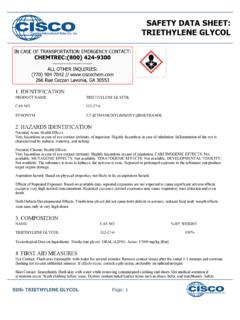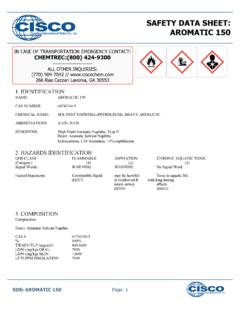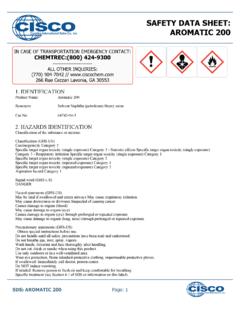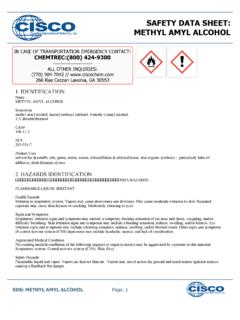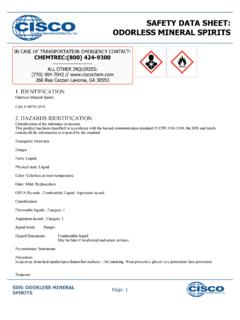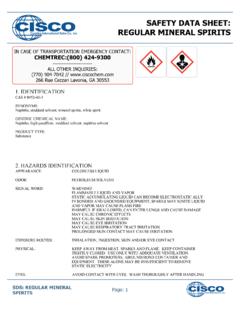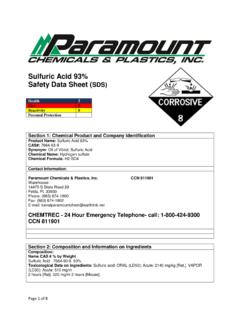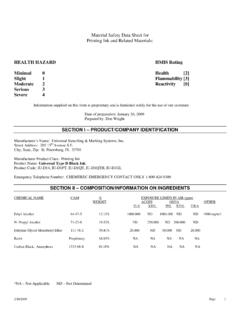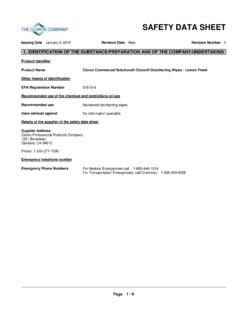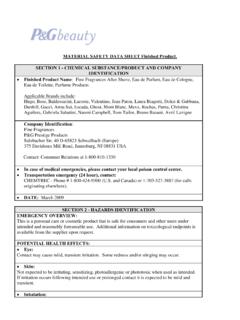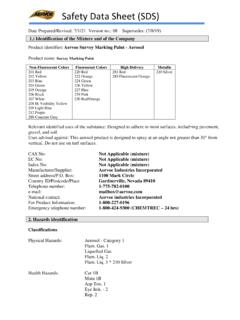Transcription of SAFETY DATA SHEET: NONYL PHENOL 9 - ciscochem.com
1 SAFETY data sheet : NONYL PHENOL 91. IDENTIFICATIONCOMMON NAME:TERGITOL NP-9, SUFACTANTSYNONYM:Poly(oxy-1,2-ethanediyl ), . (4-nonylphenyl) NAME: NONYL PHENYL POLYETHYLENE glycol ETHER2. HAZARDS IDENTIFICATIONP otential Acute Health Effects:Hazardous in case of eye contact (irritant). Slightly hazardous in case of skin contact (irritant, permeator), of ingestion, of Chronic Health Effects:CARCINOGENIC EFFECTS: Not EFFECTS: Not EFFECTS: Not TOXICITY: Not or prolonged exposure is not known to aggravate medical COMPOSITIONNAMECAS - NO% BY WEIGHT1) Poly (oxy-1,2-Ethanediyl),alpha-(4-nonyphenyl )-omega-hydroxy,branched127087-87-0>972) Polyethylene Glycol25322-68-3<33) Dinonylphenyl Polyoxyethylene9014-93-1<2 Toxicological data Tergitol NP-9, Surfactant:on IngredientsORAL (LD50): Acute: 960-3980 mg/kg [Rat].
2 DERMAL (LD50): Acute: 2000-2991 mg/kg [Rabbit].4. FIRST AID MEASURESEye Contact Skin ContactIN CASE OF TRANSPORTATION EMERGENCY CONTACT:CHEMTREC:(800) 424-9300-----------------------ALL OTHER INQUIRIES:(770) 904-7042 // Rue Cezzan Lavonia, GA 30553 Page: 1 SDS: NONYL PHENOL 9 Check for and remove any contact lenses. In case of contact, immediately flush eyes with plenty of water for at least 15 water may be used. Get medical attention if irritation ContactIn case of contact, immediately flush skin with plenty of water. Cover the irritated skin with an emollient. Remove contaminatedclothing and shoes. Cold water may be used. Wash clothing before reuse. Thoroughly clean shoes before reuse. Get Skin ContactNot availableInhalationIf inhaled, remove to fresh air.
3 If not breathing, give artificial respiration. If breathing is difficult, give oxygen. Get InhalationNot availableIngestionDo NOT induce vomiting unless directed to do so by medical personnel. Never give anything by mouth to an unconscious person. Iflarge quantities of this material are swallowed, call a physician immediately. Loosen tight clothing such as a collar, tie, belt IngestionNot available5. FIRE FIGHTING MEASURESF lammability of the Product May be combustible at high temperatureAuto-Ignition Temperature not availableFlash PointsCLOSED CUP: 247 C ( F). (Pensky-Martens.) OPE N CUP: 282 C ( F) (Cleveland) Flammable LimitsNot availableProducts of Combustionnot availableFire Hazards in Presence of Various SubstancesSlightly flammable to flammable in presence of open flames and sparks, of heat.
4 Non-flammable in presence of Hazards in Presence of Various SubstancesRisks of explosion of the product in presence of mechanical impact: Not available. Risks of explosion of the product in presence ofstatic discharge: Not Fighting Media and InstructionsSMALL FIRE: Use DRY chemical FIRE: Use water spray, fog or foam. Do not use water Remarks on Fire HazardsNot availableSpecial Remarks on Explosion Hazardsnot availablePage: 2 SDS: NONYL PHENOL 96. ACCIDENTAL RELEASE MEASURESS mall SpillDilute with water and mop up, or absorb with an inert dry material and place in an appropriate waste disposal container. Finishcleaning by spreading water on the contaminated surface and dispose of according to localand regional authority SpillAbsorb with an inert material and put the spilled material in an appropriate waste disposal.
5 Finish cleaning by spreading water on thecontaminated surface and allow to evacuate through the sanitary HANDLING AND STORAGEP recautionsKeep away from heat. Keep away from sources of ignition. Ground all equipment containing material. Do not ingest. Do not breathegas/fumes/ vapor/spray. Wear suitable protective clothing. If ingested, seek medical advice immediately and show the container orthe label. Keep away from incompatibles such as oxidizing agents, acids, container tightly closed. Keep container in a cool, well-ventilated EXPOSURE CONTROLS AND PERSONAL PROECTIONE ngineering ControlsProvide exhaust ventilation or other engineering controls to keep the airborne concentrations of vapors below their respectivethreshold limit value.
6 Ensure that eyewash stations and SAFETY showers are proximal to the work-station locationPersonal ProtectionSplash goggles. Lab coat. Gloves. Respiratory protection is not necessary for normal handling. Good room ventilation or use of localexhaust (fume hood) is sufficient. Use a vapor respirator under conditions where exposure to the substance is apparent ( of high concentrations of mist or vapor, inadequate ventilation, development of respiratory tract irritation), andengineering controls are not feasible. Be sure to use an approved/certified respirator or equivalentPersonal Protection in Case of a Large SpillSplash goggles. Full suit. Boots. Gloves. Suggested protective clothing might not be sufficient; consult a specialist BEFORE handling this LimitsNot available9.
7 PHYSICAL AND CHEMICAL PROPERTIESP hysical state and appearance:LiquidOdor:MildTaste:Not availableColor:Colorless to light yellowMolecular Weightnot availablepH (1% soln/water)6 (Acidic)Boiling PointDecomposition temperature: >250 C (482 F)Melting Point Freezing point: C ( F) Pour Point: -1 CCritical TemperatureNot availablePage: 3 SDS: NONYL PHENOL 9 Specific (Water = 1)Vapor Pressure< kPa (@ 20 C)< @ 20 CVapor Density>1 (Air = 1)VolatilityNot availableOdor ThresholdNot availableWater/Oil Distribution CoefficientNot availableIonicity (in water)Non-ionicDispersion PropertiesSee solubility in waterSolubility Soluble in cold water, hot water10. STABILITY AND REACTIVITYS tabilityThe product is stableInstability TemperatureNot availableConditions of InstabilityAvoid prolonged excess heat which may cause product incompatible materials such as strong bases strong acids, strong oxidizing agents andmaterials reactive with hydroxyl with varioussubstancesReactive with oxidizing agents, acids, alkalisCorrositivityNot availableSpecial Remarks on ReactivityNormally un reactive.
8 However, avoid strong bases at high temperatures, strong acids, strongoxidizing agents, and materials reactive with hydroxyl remarks on Corrositivitynot availablePolymerizationwill not occur11. TOXICOLOGICAL INFORMATIONR outes of EntryAbsorbed through skin. Eye contact. IngestionToxicity to Animals:Acute oral toxicity (LD50): 960-3980 mg/kg [Rat].Acute dermal toxicity (LD50): 2000-2199 mg/kg [Rabbit].Chronic Effects on HumansNot AvailableOther Toxic Effects on HumansHazardous in case of eye contact (irritant).Slightly hazardous in case of skin contact (irritant, permeator), of ingestion, of Remarks on Toxicity to AnimalsNot availableSpecial Remarks on Chronic Effects on HumansPage: 4 SDS: NONYL PHENOL 9 May contain trace amounts of Ethylene oxide (< ),1,4-dioxane (< ) which can cause cancer.
9 May contain traceamounts of Ethylene oxide (< ) which may cause birth defects or other reproductive cause adverse reproductive effects and birth defects based on animal Remarks on other Toxic Effects on Humans:Acute Potential Health Effects:Skin: May cause mild skin : Causes eye irritation. May cause corneal may cause abdominal discomfort, nausea, vomiting, and : Mist may cause irritation of the upper respiratory tract (nose, throat).Chronic Potential Health Effects:Skin: Prolonged or widespread contact is not likely to result in absorption of potentially harmful amounts. Ingestion: Prolonged orrepeated ingestion may affect the ECOLOGICAL INFORMATIONECOTOXICITYE cotoxicity in water (LC50): mg/l 48 hours [Daphnia].
10 Mg/l 96 hours [Daphnia]. mg/l 96 hours [Fish (FatheadMinnow)]. mg/l 96 hours [Fish (Fathead Minnow)]. mg/l 96 hours [Fish (Fathead Minnow)].BOD5 AND CODNot availableProducts of BiodegradationPossibly hazardous short term degradation products are not likely. However, long term degradation products may of the Products of BiodegradationNot AvailableSpecial Remarks on the Products of BiodegradationNot available13. DISPOSAL CONSIDERATIONSW aste DisposalWaste must be disposed of in accordance with federal, state and local environmental control TRANSPORT INFORMATIONDOT CLASSIFICATIONNot a DOT controlled material (USA)IdentificationNot applicableSpecial Provisions for TransportNot applicable15. REGULATORY INFORMATIONFEDERAL AND STATE REGULATIONSC alifornia prop.


